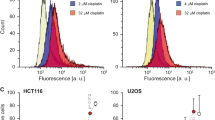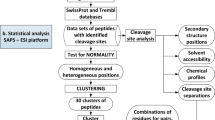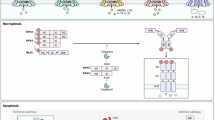Abstract
Caspases, cysteine proteases with aspartate specificity, are key players in programmed cell death across the metazoan lineage. Hundreds of apoptotic caspase substrates have been identified in human cells. Some have been extensively characterized, revealing key functional nodes for apoptosis signaling and important drug targets in cancer. But the functional significance of most cuts remains mysterious. We set out to better understand the importance of caspase cleavage specificity in apoptosis by asking which cleavage events are conserved across metazoan model species. Using N-terminal labeling followed by mass spectrometry, we identified 257 caspase cleavage sites in mouse, 130 in Drosophila, and 50 in Caenorhabditis elegans. The large majority of the caspase cut sites identified in mouse proteins were found conserved in human orthologs. However, while many of the same proteins targeted in the more distantly related species were cleaved in human orthologs, the exact sites were often different. Furthermore, similar functional pathways are targeted by caspases in all four species. Our data suggest a model for the evolution of apoptotic caspase specificity that highlights the hierarchical importance of functional pathways over specific proteins, and proteins over their specific cleavage site motifs.
Similar content being viewed by others
Log in or create a free account to read this content
Gain free access to this article, as well as selected content from this journal and more on nature.com
or
Abbreviations
- ppm:
-
part per million
- GST:
-
glutathione S-transferase
- GO:
-
gene ontology
- IPA:
-
Ingenuity Pathway Analysis
- SDS:
-
sodium dodecyl sulfate
- FBS:
-
fetal bovine serum
- eIF:
-
eukaryotic initiation factor
- RPL:
-
ribosomal protein, large subunit
- PBS:
-
phosphate buffered saline
- MEF:
-
mouse embryonic fibroblast
- PTM:
-
post-translational modification
- PMSF:
-
phenylmethanesulfonylfluoride
- AEBSF:
-
4-(2-Aminoethyl) benzenesulfonyl fluoride hydrochloride
- EDTA:
-
Ethylenediaminetetraacetic acid
- IAM:
-
iodoacetamide
References
Zmasek CM, Zhang Q, Ye Y, Godzik A . Surprising complexity of the ancestral apoptosis network. Genome Biol 2007; 8: R226.
Van Damme P, Martens L, Van Damme J, Hugelier K, Staes A, Vandekerckhove J et al. Caspase-specific and nonspecific in vivo protein processing during Fas-induced apoptosis. Nat Methods 2005; 2: 771–777.
Dix MM, Simon GM, Cravatt BF . Global mapping of the topography and magnitude of proteolytic events in apoptosis. Cell 2008; 134: 679–691.
Mahrus S, Trinidad JC, Barkan DT, Sali A, Burlingame AL, Wells JA . Global sequencing of proteolytic cleavage sites in apoptosis by specific labeling of protein N termini. Cell 2008; 134: 866–876.
Rawlings ND, Barrett AJ, Bateman A . MEROPS: the peptidase database. Nucleic Acids Res 2010; 38: D227–D233.
Crawford ED, Wells JA . Caspase substrates and cellular remodeling. Annu Rev Biochem 2011; 80: 1055–1087.
Erwin DH, Davidson EH . The last common bilaterian ancestor. Development 2002; 129: 3021–3032.
Neduva V, Russell R . Linear motifs: evolutionary interaction switches. FEBS Lett 2005; 579: 3342–3345.
Tan C, Bodenmiller B, Pasculescu A . Comparative analysis reveals conserved protein phosphorylation networks implicated in multiple diseases. Sci Signal 2012; 2: ra39.
Shimbo K, Hsu GW, Nguyen H, Mahrus S, Trinidad JC, Burlingame AL et al. Quantitative profiling of caspase-cleaved substrates reveals different drug-induced and cell-type patterns in apoptosis. Proc Nat Acad Sci USA 2012; 109: 12432–12437.
Schechter I, Berger A . On the size of the active site in proteases. I. Papain. Biochem Biophys Res Commun 1967; 27: 157–162.
Schrimpf S, Weiss M, Reiter L, Ahrens C . Comparative functional analysis of the Caenorhabditis elegans and Drosophila melanogaster proteomes. PLoS Biology 2009; 7: 616–627.
Weiss M, Schrimpf S, Hengartner M . Shotgun proteomics data from multiple organisms reveals remarkable quantitative conservation of the eukaryotic core proteome. Proteomics 2010; 10: 1297–1306.
Agard NJ, Mahrus S, Trinidad JC, Lynn A, Burlingame AL, Wells JA . Global kinetic analysis of proteolysis via quantitative targeted proteomics. Proc Nat Acad Sci USA 2012; 109: 1913–1918.
Taylor RC, Brumatti G, Ito S, Hengartner MO, Derry WB, Martin SJ . Establishing a blueprint for CED-3-dependent killing through identification of multiple substrates for this protease. J Biol Chem 2007; 282: 15011–15021.
Colaert N, Helsens K, Martens L, Vandekerckhove J, Gevaert K . Improved visualization of protein consensus sequences by iceLogo. Nat Methods 2009; 6: 786–787.
Thornberry N, Rano T, Peterson E, Rasper D, Timkey T, Garcia-Calvo M et al. A combinatorial approach defines specificities of members of the caspase family and granzyme B. J Biol Chem 1997; 272: 17907.
Lüthi AU, Martin SJ . The CASBAH: a searchable database of caspase substrates. Cell Death Differ 2007; 14: 641–650.
Schilling O, Overall C . Proteome-derived database-searchable peptide libraries for identifying protease cleavage sites. Nat Biotechnol 2008; 26: 685–694.
Chang TK, Jackson DY, Burnier JP, Wells JA . Subtiligase: a tool for semisynthesis of proteins. Proc Natl Acad Sci USA 1994; 91: 12544–12548.
Fontana A, de Laureto PP, Spolaore B, Frare E, Picotti P, Zambonin M . Probing protein structure by limited proteolysis. Acta Biochim Pol 2004; 51: 299–321.
Petersen B, Petersen T, Andersen P, Nielsen M, Lundegaard C . A generic method for assignment of reliability scores applied to solvent accessibility predictions. BMC Struct Biol 2009; 9: 51.
Powell S, Szklarczyk D, Trachana K, Roth A, Kuhn M, Muller J et al. eggNOG v3.0: orthologous groups covering 1133 organisms at 41 different taxonomic ranges. Nucleic Acids Res 2012; 40: D284–D289.
Lamkanfi M, Declercq W, Kalai M, Saelens X, Vandenabeele P . Alice in caspase land. A phylogenetic analysis of caspasesfrom worm to man. Cell Death Differ 2002; 9: 358–361.
Katoh K, Toh H . Recent developments in the MAFFT multiple sequence alignment program. Brief Bioinform 2008; 9: 286–298.
Waterhouse AM, Procter JB, Martin DMA, Clamp M, Barton GJ . Jalview Version 2--a multiple sequence alignment editor and analysis workbench. Bioinformatics 2009; 25: 1189–1191.
Consortium U . Reorganizing the protein space at the Universal Protein Resource (UniProt). Nucleic Acids Res 2012; 40: D71–D75.
Pál C, Papp B, Lercher MJ . An integrated view of protein evolution. Nat Rev Genet 2006; 7: 337–348.
Wildes D, Wells JA . Sampling the N-terminal proteome of human blood. Proc Nat Acad Sci USA 2010; 107: 4561–4566.
Beltrao P, Trinidad JC, Fiedler D, Roguev A, Lim WA, Shokat KM et al. Evolution of phosphoregulation: comparison of phosphorylation patterns across yeast species. PLoS Biol 2009; 7: e1000134.
Holt LJ, Tuch BB, Villén J, Johnson AD, Gygi SP, Morgan DO . Global analysis of Cdk1 substrate phosphorylation sites provides insights into evolution. Science 2009; 325: 1682–1686.
Tsong AE, Tuch BB, Li H, Johnson AD . Evolution of alternative transcriptional circuits with identical logic. Nature 2006; 443: 415–420.
Tuch BB, Galgoczy DJ, Hernday AD, Li H, Johnson AD . The evolution of combinatorial gene regulation in fungi. PLoS Biol 2008; 6: e38.
Booth LN, Tuch BB, Johnson AD . Intercalation of a new tier of transcription regulation into an ancient circuit. Nature 2010; 468: 959–963.
Creagh E, Brumatti G, Sheridan C, Duriez P, Taylor R, Cullen S et al. Bicaudal is a conserved substrate for drosophila and mammalian caspases and is essential for cell survival. PLoS One 2009; 4: 3.
Yokoyama H, Mukae N, Sakahira H, Okawa K, Iwamatsu A, Nagata S . A novel activation mechanism of caspase-activated DNase from Drosophila melanogaster. J Biol Chem 2000; 275: 12978–12986.
Amarneh B, Matthews KA, Rawson RB . Activation of sterol regulatory element-binding protein by the caspase Drice in Drosophila larvae. J Biol Chem 2009; 284: 9674–9682.
Fuentes-Prior P, Salvesen GS . The protein structures that shape caspase activity, specificity, activation and inhibition. Biochem J 2004; 384 (Pt 2): 201–232.
Boucher D, Blais V, Denault J-B . Caspase-7 uses an exosite to promote poly(ADP ribose) polymerase 1 proteolysis. Proc Nat Acad Sci USA 2012; 109: 5669–5674.
McQuilton P, Pierre SE, Thurmond J, Consortium F . FlyBase 101--the basics of navigating FlyBase. Nucleic Acids Res 2012; 40: D706–D714.
Wallace JA, Felsenfeld G . We gather together: insulators and genome organization. Curr Opin Genet Dev 2007; 17: 400–407.
Boyle EI, Weng S, Gollub J, Jin H, Botstein D, Cherry JM et al. GO TermFinder--open source software for accessing Gene Ontology information and finding significantly enriched Gene Ontology terms associated with a list of genes. Bioinformatics 2004; 20: 3710–3715.
Acknowledgements
We thank Sami Mahrus, David Wildes, Nicholas Agard, Hikari Yoshihara, Huy Nguyen, Gerald Hsu, and Kazutaka Shimbo for contributing to the human caspase substrate data set. We also thank Cynthia Kenyon and Aimee Kao for assistance with the C. elegans work, and David Maltby, Jonathan Trinidad, and Shenheng Guan and the rest of the UCSF Mass Spectrometry Facility, plus Iman Mohtashemi and Yan Chen of Thermo Scientific, for mass spectrometry assistance. We thank Bent Petersen for assistance with the NetSurfP server. This project was supported by a grant from the UCSF Stephen and Nancy Grand Multiple Myeloma Translational Initiative. It was also supported by the National Science Foundation GRFP (EDC), NIH Training Grant T32 GM007175 (JES and PCB), the Pharmaceutical Research and Manufacturers of America (AEB), National Institutes of Health R01 GM60595 (PCB), and National Institutes of Health R01 GM081051 (JAW). Mass spectrometry was performed at the Bio-Organic Biomedical Mass Spectrometry Resource at UCSF (ALB, Director), which is supported by grants from the National Center for Research Resources (5P41RR001614) and the National Institute of General Medical Sciences (8 P41 GM103481) from the National Institutes of Health.
Author information
Authors and Affiliations
Corresponding author
Ethics declarations
Competing interests
The authors declare no conflict of interest.
Additional information
Edited by G Salvesen
Supplementary Information accompanies the paper on Cell Death and Differentiation website
Rights and permissions
About this article
Cite this article
Crawford, E., Seaman, J., Barber, A. et al. Conservation of caspase substrates across metazoans suggests hierarchical importance of signaling pathways over specific targets and cleavage site motifs in apoptosis. Cell Death Differ 19, 2040–2048 (2012). https://doi.org/10.1038/cdd.2012.99
Received:
Revised:
Accepted:
Published:
Issue date:
DOI: https://doi.org/10.1038/cdd.2012.99
Keywords
This article is cited by
-
Microtubule disassembly by caspases is an important rate-limiting step of cell extrusion
Nature Communications (2022)
-
Caspase dependent apoptosis is required for anterior regeneration in Aeolosoma viride and its related gene expressions are regulated by the Wnt signaling pathway
Scientific Reports (2020)
-
A pro longevity role for cellular senescence
GeroScience (2020)
-
Caspases maintain tissue integrity by an apoptosis-independent inhibition of cell migration and invasion
Nature Communications (2018)
-
Cacidases: caspases can cleave after aspartate, glutamate and phosphoserine residues
Cell Death & Differentiation (2016)



